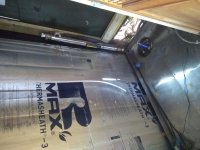DiploStrat
Expedition Leader
This is simply brilliant! I have always dismissed recirculating showers as complex cures looking for a disease. Using a bowl, we use about two gallons for a shower, but it is definitely a military/navy shower - no standing under running water. What you describes uses about the same amount of water, but gives you the luxury of continuous water. And even saves water with two or more people.Hi blue, looks fancy.
We have used our diy recirculating shower now for a couple of years .
We have it in both of our buses and it will also be part of our 404 unimog build.
It uses a sump pump that is recessed in the lower section of the shower tub and a heated shower head with an additional coolant heatexchanger. In reality it is easier to run the electric shower head. There are no filters except a course dirt / hair filter to protect the pump. In the large bus we have a big uv filter but sofar never used it.
Procedure is. Allow 3/4 gallon of hot water in the shower tub, turn on pump, turn on electric to shower head, wait 30 seconds to allow water to circulate and get to correct temperature.
Shower with soap . Because the soapy water gets recirculated as well you will end up very clean. If you feel you are done then stop the pump. Pull sump pump up..this opens the drain below the pump and allow water out of the tub to be drained, also the shower head and pump backflushes because of the height difference..
Use another 3/4 gallon and repeat with clean water to rinse off or hang as long as you want.
Normally when we are boondocking with our two kids then the next person uses the rinse water to soap up the next person.
Electric use about 2kw to keep the water hot. We have plenty of solar to support that.
Good luck with your build.
Johan
As I have no space under our shower, I just don't think I could retrofit it, but, as noted, it is a great implementation. Especially if crossed with an engine heat exchanger hot water system. Most of the time your electrical consumption for water heating would be very low.
Best idea I have seen in years!


